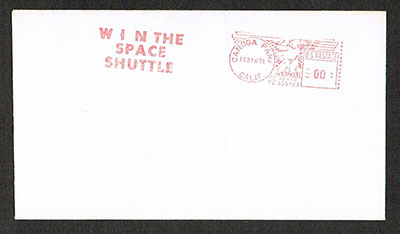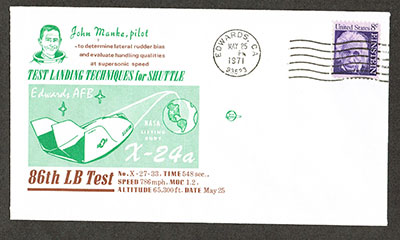This unassuming Space City Cover Society (SCCS) cacheted space cover is postmarked June 10, 1971, at Houston, Texas, on the occasion of Houston's selection on this date as the Space Shuttle Control Center (Mission Control Center) for the new Space Shuttle Program presently under Presidential review. This early space shuttle concept of operations cover depicts six stages from launch of the space shuttle into Earth orbit, working in space on orbit, reentry back to Earth, and then landing on a designated runway. For space shuttle cover collectors, this may be the first space cover for the fledgling Space Shuttle Program.
The Space Shuttle Control Center cover shown above predates the announcement of NASA's Space Shuttle Program by six months. On January 5, 1972, President Richard Nixon and NASA Administrator James Fletcher, discuss the importance of the Space Transportation System for America's space program. Their meeting at the Western White House in San Clemente, California, is followed by a press conference in which President Nixon announces his approval of the new Space Shuttle Program.
Space Cover #156, First Space Shuttle Cover?
President Nixon used the wording "space shuttle" to name the complicated and unwieldy designation "space transportation system, Orbiter Vehicle, OV-101," in NASA parlance that NASA officials had conferred upon the new transportation system to follow the successful conclusion of the U.S. Apollo Moon landing program. This indeed was a historic moment in the U.S. space program with the President graphically outlining NASA's vision to the American people of the new space transportation program to come.
NASA Administrator, James Fletcher, present at the President's press conference in San Clemente, California, also commented, "By the end of this decade, the nation will have the means of getting men and equipment to and from space routinely, on a moment's notice if necessary, and at a small fraction of today's cost. This will be done within the framework of a useful total space program of science, exploration, and applications at approximately the present overall level of the space budget."
After President Nixon's press conference, NASA Administrator Fletcher, speaking further to the press, confirmed that in-depth studies by NASA and aerospace commercial industry had reached the point of departure to proceed with actual development of the space shuttle vehicle, SSV, in NASA phraseology. He noted that the decision to proceed, and which the President had now approved, aligned with budgeting presented to and approved by the U.S. Congress in NASA's current fiscal year 1972 budget. He adamantly commented, "The decision by the President is a historic step in the nation's space program--it will change the nature of what man can do in space."
Administrator Fletcher described what the space shuttle would look like. He continued, "The Space Shuttle will consist of an aircraft-like orbiter, about the size of a DC-9. It will be capable of carrying into orbit and back again to Earth useful payloads up to 15 ft. in diameter by 60 ft. long, and weighing up to 65,000 lb. Fuel for the orbiter's liquid-hydrogen / liquid-oxygen engines will be carried in an external tank that will be jettisoned in orbit." He stated that the space shuttle would be launched by an unmanned rocket booster and would be able to operate in space for about a week. The astronauts on the shuttle would be able to launch, service, and recover unmanned spacecraft. They would also be able to perform experiments and other useful operations in Earth orbit. In the future, they would be able to resupply crews and equipment modules which they themselves would have brought to space via the space shuttle. And, upon mission completion, the space shuttle crew would return to Earth and land the space shuttle on a designated runway much like a commercial aircraft would land.
Fletcher also laid out an immediate time line for building the space shuttle. By spring, NASA would issue a request for proposals to prospective Government contractors. By the summer, NASA would award the space shuttle contract and development work would start. In the interim two months before this, NASA and interested contractors would focus study efforts on technical areas in which further detailed information would be required before NASA's request for proposal for the space shuttle could be issued. The technical comparisons of pressure-fed liquid fuel and solid fuel rocket motor options for the booster stage also were key engineering and technical questions that would need to be addressed.
I offer a belated happy birthday announcement to the Space Shuttle Program and the many thousands of people, both in the U.S. and throughout the world, who made the program real, operational, and successful throughout the Space Shuttle Program's forty years of service. It will indeed be a tough act to follow.
Steve Durst, SU 4379














